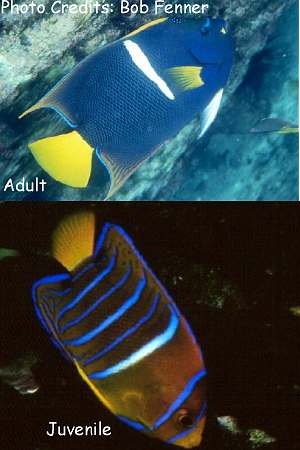
By Bob Goemans

Not Reef Tank Suitable
Likely Fish-Only Tank Suitable
Range: Eastern Pacific Ocean: West Coast of tropical America as far north as the Gulf of California/Sea of Cortez
Size: 14 inches (36 cm)
Natural Environment: Inhabits coastal rocky and coral reefs mainly at depths of 3 to 35 feet (1 – 10 m) and feeds primarily on various forms of algae and also sponges, crustaceans, and plankton.
General Husbandry: Both the juvenile and adult are quite pretty, with the juvenile having a brownish orange body with several blue vertical bands and one white vertical band near the head, and a brown vertical bar through the eyes. It tail is yellow, as are the pelvic fins, and its dorsal and anal fins, basically a brownish orange, are edged in bright blue. Its pectoral fins are brownish orange, the same as the body color. As for the adult, it has a dark bluish body, with one white vertical band located about one third of the way back on the body, and its dorsal and anal fins, basically a brownish orange, are edged in bright blue. Its tail is bright yellow, pelvic fins are white, and its pectoral fins are yellow. There’s also a black crown area on the top head that contains numerous bright blue dots and a blue narrow band that crosses the forehead from eye to eye. Keep in mind there are other small differences depending upon the area of collection and age of the specimen.
When first introduced into the aquarium, preferably a well-established fish-only aquarium with lots of live rock and cave areas, adults or juveniles should be offered several daily feedings so as to quickly acclimate it to its surroundings. Like many others in this genus, their captive diet should consist of a wide variety of frozen foods including fortified brine shrimp, mysis, and especially those containing sponge matter/angelfish food preparations and continued to be offered several times daily after its acclimated to its surroundings. Furthermore, flake foods, and especially those containing Spirulina and/or Nori should be offered frequently, along with fresh broccoli and macroalgae, as ‘greens’ make up a large portion of this species diet.
Depending upon its tankmates, juveniles may be somewhat shy when first entering the aquarium, and may hide in caves and crevices. But as time passes, will become more outgoing and begin to establish its territory. As for adults, one of the largest and feistiest in this genus, it all depends on aquarium size and tankmates, but its preferable it be the last angelfish to be added to the aquarium.
Taxonomy:
Order: Perciformes
Suborder: Percoidei
Family: Pomacanthidae
Genus: Holacanthus
FYI: Keeping more than one genus of angelfishes in the same aquarium is possible, yet depends upon several aspects. The following suggested circumstances are just that, possibilities that when heeded and adjusted to actual aquarium conditions ‘may’ make multiple angelfish collections feasible.
Aquarium size – the larger the better.
Species from the same genus should not be in the same aquarium.
The smallest and most docile genus species should be the first introduced with the largest and most malicious the last to be added.
Do not place similar coloration species in the same aquarium.
Those already in the aquarium should be well fed before adding a newcomer.
Have sufficient hiding places/rocky caves.
Do not overfeed meaty foods, especially juveniles, as it may lead to a fatty deposit around the liver that could stop production of vitamin A. This could cause blindness, often referred to as nutritional blindness.
Keep in mind all angels have cheekspines at the edge of their gill cover; therefore use caution when handling and also avoid using a net to capture it, as it may become stuck or tangled in the net and become damaged when removed.
Experience Level: Intermediate
Temperament: Semi-aggressive
Diet: Omnivore
Acclimation Time: 30 minutes+
Aquarium Environment: Fish-only and Reef Aquariums (See Below)
Reef Safe: Juveniles – Yes/Adults - No - will nip clam mantles, large and small polyped stony (LPS/SPS) corals, and also some soft corals and tubeworms.
Minimum Tank Size: 180 gallons
Temperature Range: 66 - 81°F (19 – 27°C)
Specific Gravity: 1.020 - 1.026
pH: 8.0 - 8.5
